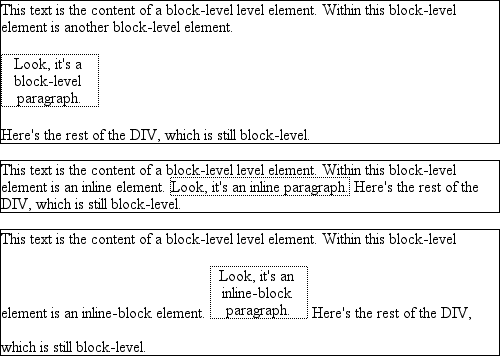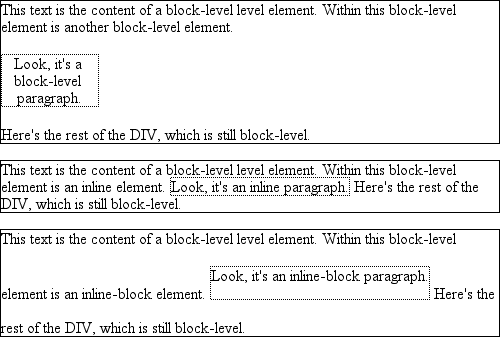CSS: The Definitive Guide, 3rd Edition (31 page)
Read CSS: The Definitive Guide, 3rd Edition Online
Authors: Eric A. Meyer
Tags: #COMPUTERS / Web / Page Design

As I mentioned briefly in
Chapter 1
, you can affect the way a user agent
displays by setting a value for the propertydisplay.
Now that we've taken a close look at visual formatting, let's revisit thedisplayproperty and discuss two more of its values using
concepts from this chapter.
display
- Values:
none|inline|block|inline-block|list-item|run-in|table|inline-table|table-row-group|table-header-group|table-footer-group|table-row|table-column-group|table-column|table-cell|table-caption|inherit- Initial value:
inline- Applies to:
All elements
- Inherited:
No
- Computed value:
Varies for floated, positioned, and root elements (see CSS2.1, section
9.7); otherwise, as specified- Note:
The values
compactandmarkerappeared in CSS2 but were dropped from
CSS2.1 due to a lack of widespread support
We'll ignore the table-related values, since they are covered in
Chapter 11
, and we'll also ignore the valuelist-itemsince I deal with lists in detail in
Chapter 12
. We've spent quite some time discussingblockandinlineelements, but let's spend a moment talking about how altering an
element's display role can alter layout before we look atinline-blockandrun-in.
When it comes to styling a document, it's obviously
handy to be able to change the display role of an element. For example, suppose you
have a series of links in adivthat you'd like to
lay out as a vertical sidebar:
You could put all the links into table cells, or wrap each one in its owndiv—or you could just make them all block-level
elements, like this:
div#navigation a {display: block;}
This will make everyaelement within the
navigationdiva block-level element. If you add
on a few more styles, you could have a result like that shown in
Figure 7-49
.

Figure 7-49. Changing the display role from inline to block
Changing display roles can be useful in cases where you want non-CSS browsers to
get the navigation links as inline elements but to lay out the same links as
block-level elements. With the links as blocks, you can style them as you woulddivelements, with the advantage that the
entire element box becomes part of the link. Thus, if a user's mouse pointer hovers
anywhere in the element box, he can then click the link.
You may also want to make elements inline. Suppose you have an unordered list of
names:
- Bob C.
- Marcio G.
- Eric M.
- Kat M.
- Tristan N.
- Arun R.
- Doron R.
- Susie W.
Given this markup, say you want to make the names into a series of inline names
with vertical bars between them (and on each end of the list). The only way to do so
is to change their display role. The following rules will have the effect shown in
Figure 7-50
:
#rollcall li {display: inline; border-right: 1px solid; padding: 0 0.33em;}
#rollcall li:first-child {border-left: 1px solid;}

Figure 7-50. Changing the display role from list-item to inline
There are plenty of other ways to usedisplayto your advantage in design. Be creative and see what you can invent!
Be careful to note, however, that you are changing the display role of
elements—not changing their inherent nature. In other words, causing a paragraph to
generate an inline-level box does
not
turn that paragraph into
an inline element. In XHTML, for example, some elements are block while others are
inline. (Still others are "flow" elements, but we're ignoring them for the moment.)
An inline element can be a descendant of a block element, but the reverse is not
true. Thus, while a link can be placed inside a paragraph, a link cannot be wrapped
around a paragraph. This will hold true no matter how you style the elements in
question. Consider the following markup:
this is wrong!
The markup will not validate because the block element (p) is nested inside an inline element (a). The changing of display roles does nothing to change this.displayis named such because it affects how the element
is displayed, not what kind of element it is.
As befits the hybrid look
of the value nameinline-block, inline-block
elements
are indeed a hybrid of block-level and inline
elements. This display value is new in CSS2.1.
An inline-block element relates to other elements and content as an inline box. In
other words, it's laid out in a line of text just as an image would be, and, in fact,
inline-block elements are formatted within a line as a replaced element. This means
the bottom of the inline-block element will rest on the baseline of the text line by
default and will not line-break within itself.
Inside the inline-block element, the content is formatted as though the element
were block-level. The propertieswidthandheightapply to it, as they do to any
block-level or inline replaced element, and those properties will increase the height
of the line if they are taller than the surrounding content.
Let's consider some example markup that will help make this clearer:
This text is the content of a block-level level element. Within this
block-level element is another block-level element.Look, it's a block-level
Here's the rest of the DIV, which is still block-level.
paragraph.
This text is the content of a block-level level element. Within this
block-level element is an inline element.Look, it's an inline
Here's the rest of the DIV, which is still block-level.
paragraph.
This text is the content of a block-level level element. Within this
block-level element is an inline-block element.Look, it's an inline-block
Here's the rest of the DIV, which is still block-level.
paragraph.
To this markup, we apply the following rules:
div {margin: 1em 0; border: 1px solid;}
p {border: 1px dotted;}
div#one p {display: block; width: 6em; text-align: center;}
div#two p {display: inline; width: 6em; text-align: center;}
div#three p {display: inline-block; width: 6em; text-align: center;}
The result of this style sheet is depicted in
Figure 7-51
.

Figure 7-51. The behavior of an inline-block element
Notice that in the seconddiv, the inline
paragraph is formatted as normal inline content, which meanswidthandtext-alignare ignored
(since they do not apply to inline elements). For the thirddiv, however, the inline-block paragraph honors both properties, since
it is formatted as a block-level element. That paragraph also forces its line of text
to be much taller, since it affects line height as though it were a replaced element.
If an inline-block element'swidthis not
defined or explicitly declaredauto, the element
box will shrink to fit the content. That is, the element box is exactly as wide as
necessary to hold the content, and no wider. Inline boxes act the same way, although
they can break across lines of text, just as inline-block elements cannot. Thus, the
following rule, when applied to the previous markup example:
div#three p {display: inline-block; height: 2em;}
will create a tall box that's just wide enough to enclose the content, as shown in
Figure 7-52
.

Figure 7-52. Auto-sizing of an inline-block element
Inline-block elements can be useful if, for example, you have a set of five
hyperlinks that you want to be of equal width within a toolbar. To make them all 20
percent of the width of their parent element, but still leave them inline, declare:
#navbar a {display: inline-block; width: 20%;}
CSS2 introduced the valuerun-in, another interesting block/inline hybrid that can make some
block-level elements an inline part of a following element. This ability is useful
for certain heading effects that are quite common in print typography, where a
heading will appear as part of a paragraph of text.
In CSS, you can make an element run-in simply by changing itsdisplayvalue
and
by making the
next element box block-level. Note that I'm talking here about
boxes
, not the elements themselves. In other words, it doesn't
matter if an element is block or inline. All that matters is the box that element
generates. Astrongelement set todisplay:blockgenerates a block-level box; a paragraph set todisplay:inlinegenerates an inline
box.
So, to rephrase: if an element generates a run-in box, and a block box follows
that box, then the run-in element will be an inline box at the beginning of the block
box. For example:
font-weight: bold;">Run-in Elements
Another interesting block/inline hybrid is the valuerun-in, introduced
in CSS2, which has the ability to take block-level elements and make them an inline
part of a following element. This is useful for certain heading effects that are
quite common in print typography, where a heading will appear as part of a paragraph
of text.
Since the element following theh3generates a
block-level box, theh3element will be turned
into an inline element at the beginning of thepelement's content, as illustrated in
Figure
7-53
.

Figure 7-53. Making a heading run-in
Note how the borders of the two elements are placed. The effect of usingrun-inin this situation is exactly the same as if you'd
used this markup instead:
Run-in
Elements Another interesting block/inline hybrid is the valuerun-incode>, introduced in CSS2, which has the ability to take block-level elements and
make them an inline part of a following element. This is useful for certain heading
effects that are quite common in print typography, where a heading will appear as
part of a paragraph of text.
However, there is a slight difference between run-in boxes and the markup example.
Even though run-in boxes are formatted as inline boxes within another element, they
still inherit properties from their parent element in the document, not the element
into which they're placed. Let's extend our example to include an enclosingdivand some color:
font-weight: bold;">Run-in Elements
Another interesting block/inline hybrid is the valuerun-in, introduced
in CSS2, which has the ability to take block-level elements and make them an inline
part of a following element.
%lt;/div>In this situation, the
h3will be silver, not
black, as illustrated in
Figure 7-54
.
That's because it inherits the color value from its parent element before it is
inserted into the paragraph.Figure 7-54. Run-in elements inherit from their source parents
The important thing to remember is that
run-inwill work only if the box after the run-in box is block-level. If it is not, the
run-in box itself will be made block-level. Thus, given the following markup, theh3will remain or even become block-level,
since thedisplayvalue for thetableelement is (oddly enough)table:Prices
Apples $0.59 Peaches $0.79 Pumpkin $1.29 Pie $6.99 It's unlikely that an author would ever apply the value
run-into a naturally inline element, but if this happens, the element
will most likely generate a block-level box. For example, theemelement in the following markup would become
block-level because a block-level box does not follow it:
This is a really odd thing to do, but you could do it
if you were so inclined.WarningAt the time of this writing, very few contemporary browsers offer support for
run-in.Computed valuesThe computed value of
displaycan change if an element is floated or positioned. It can
also change when declared for the root element. In fact, thedisplay,position,
andfloatvalues interact in interesting ways.If an element is absolutely positioned, the value of
floatis set tonone. For either
floated or absolutely positioned elements, the computed value is determined by the
declared value, as shown in
Table
7-1
.Table 7-1. Computed display values
Declared value
Computed value
inline-table
table
inline,run-in,table-row-group,table-column,table-column-group,table-header-group,table-footer-group,table-row,table-cell,table-caption,inline-block
block
All others
As specifiedIn the case of the root element, declaring either of the values
inline-tableortableresults in a computed value oftable, whereas declaringnoneresults in the same computed value. All otherdisplayvalues are computed to beblock.
